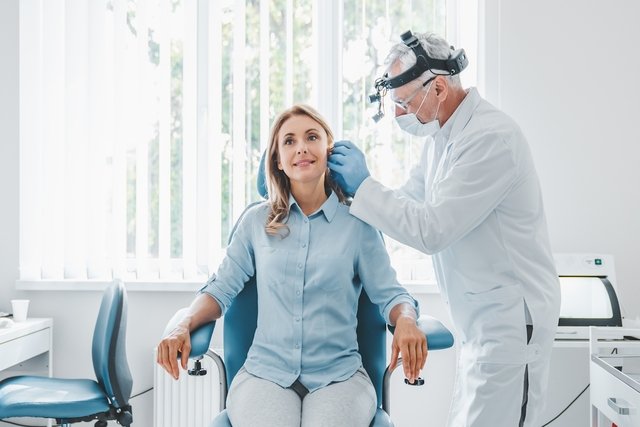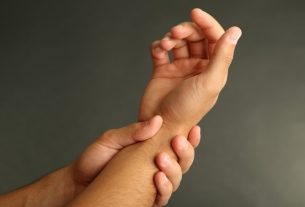Otitis is inflammation or infection in the ear affecting the external auditory canal, middle ear or the labyrinth, causing symptoms such as ear pain, itching or a feeling of pressure in the ear, fever or pus coming out of the ear.
Otitis can affect different parts of the ear, otitis is normally classified as external, medium or internal, and is caused by the use of cotton swabs, the introduction of small objects, entry of water or infection by viruses, bacteria or fungi in the ear.
The treatment of otitis is carried out by an otorhinolaryngologist, and varies according to its cause, and the use of analgesics, antifungals or antibiotics, tympanocentesis to remove secretion from the ear or surgery may be indicated.

Otitis symptoms
The main symptoms of otitis are:
- Ear pain;
- Fever;
- Itching in the ear;
- Redness or swelling of the ear;
- Presence of liquid or pus in the ear;
- Dizziness;
- Decreased hearing;
- Sensation of pressure in the ear;
- Ringing in the ear.
Additionally, babies and children with otitis may show signs such as rubbing or scratching their ears, crying a lot for no apparent reason, especially at night, becoming irritable or having difficulty sleeping.
In more complicated infections, otitis can also cause mood changes, facial paralysis, labyrinthitis or other changes in the central nervous system.
It is important to consult an otorhinolaryngologist or pediatrician, in the case of children, as soon as symptoms of otitis appear, so that their cause and type can be identified, and the most appropriate treatment can be indicated.
How to confirm the diagnosis
The diagnosis of otitis is made by an otorhinolaryngologist or pediatrician through the evaluation of symptoms, as well as when they appeared and intensity, health history and physical examination using an otoscope, a medical equipment to observe the inside of the ear.
Make an appointment with the otorhinolaryngologist in the nearest region:
Taking care of your health has never been easier!
In addition, the doctor may also order some specific tests to diagnose the type of otitis, such as a blood test, computed tomography and magnetic resonance imaging.
In some cases, the doctor may take a sample of ear secretion to be analyzed in the laboratory and identify the microorganism that is causing the infection.
Possible causes
The main causes of otitis are:
- Virus infections, such as respiratory syncytial virus, influenza, rhinovirus or adenovirus;
- Bacterial or fungal infections;
- cochlear implant;
- Allergies;
- Reflux;
- Water entering the ear;
- Introducing small objects into the ear or using cotton swabs;
- Anatomical changes in ear structures.
Furthermore, using bottles to feed babies and children can also cause milk to reflux into the middle part of the ear, facilitating an infection.
Types of otitis
The main types of otitis are:
1. Otitis externa
Otitis externa can appear in adults or children and affects the outer part of the ear up to the beginning of the eardrum, the membrane that separates the outer ear from the middle ear and is important for hearing.
This type of otitis is usually caused by the use of cotton swabs, the introduction of small objects into the ear, or exposure to heat and humidity, common after visiting the beach or swimming pool.
2. Otitis media
Otitis media affects the back of the eardrum, being common in children, generally caused as a consequence of flu or colds, or associated with viruses or bacteria. Understand better what otitis media is and the symptoms.
3. Otitis interna
Otitis interna, also known as labyrinthitis, affects the deepest region of the ear, where the labyrinth is located, a structure responsible for the body’s balance and hearing.
Read too: Labyrinthitis: what it is, symptoms, causes and treatment
This type of inflammation is generally caused by viruses or bacteria, and can cause symptoms such as dizziness, ear pain, balance problems, tinnitus or hearing loss.
4. Bacterial otitis
Bacterial otitis is caused by bacteria such as Streptococcus pneumoniae, Haemophilus influenzae or Moraxella catarrhalisfor example.
This type of bacterial infection can affect the middle ear or external ear canal and cause otitis media or otitis externa, resulting in inflammation and the emergence of symptoms.
5. Otitis eczematosa
Eczematous otitis is a chronic inflammatory skin disease called eczema that can affect any part of the inner, middle or outer ear and cause otitis.
Read too: Eczema: what it is, symptoms, causes, types and treatment
This type of otitis causes intense itching in the ear, peeling of the skin and ear pain.
6. Serous otitis
Serous otitis occurs due to the accumulation of serous or mucous fluid behind the eardrum, mainly affecting children.
This type of otitis, also called otitis media with effusion, causes symptoms such as a feeling of pressure in the ear or popping sounds, ear pain or decreased hearing.
7. Fungal otitis
Fungal otitis is caused by fungi of the species Candida albicans or Aspergillus nigermainly affecting the external ear.
This type of otitis, also called otomycosis, causes intense itching in the ear, a feeling of blocked ear or secretion coming out of the ear.
How the treatment is carried out
Treatment for otitis must be carried out under the guidance of an otorhinolaryngologist or pediatrician and varies according to the location, symptoms and cause, and aims to alleviate symptoms and combat bacteria or viruses that are causing the infection or inflammation.
The main treatments for otitis are:
1. Remedies for otitis
The use of medicines for otitis may be recommended by the doctor to alleviate symptoms of pain or discomfort in the ear or fever, and is mainly done with medications, such as paracetamol or ibuprofen, antihistamines or decongestants, which varies depending on the type of otitis.
Furthermore, if the otitis was caused by bacteria or fungi, the doctor may prescribe antibiotics or antifungals. See all remedies recommended for otitis.
In the most serious cases of otitis, treatment involves hospitalization for the administration of antibiotics directly into the vein.
2. Ear wash
In some cases of otitis externa, the doctor may also wash the ear, in the office, with warm water and apply serum or alcoholic solutions, with the help of cotton or gauze, to clean the ear.
Read too: Ear washing: what it is for, how to do it and risks
3. Timpanocentese
Tympanocentesis is a type of treatment for otitis media, performed by an otorhinolaryngologist using a fine needle and a 3 mL syringe to drain fluid from the middle ear.
This treatment is carried out in the doctor’s office, using local anesthesia.
4. Surgery
In more serious cases of otitis media, the doctor may recommend some surgeries, such as myringotomy, which is done with a small cut in the eardrum to drain fluid from the middle ear and the introduction of a flexible tube for ventilation.
Furthermore, another surgery is mastoidectomy, indicated in cases of chronic or internal otitis media, and performed by an otorhinolaryngologist to clean the mastoid bone and eliminate the infection.
Home treatment for otitis
Some home measures, such as drinking at least 2 liters of water per day, maintaining a balanced diet and applying a warm compress to the external ear area can also help in the treatment and alleviate the symptoms of otitis media.
Read too: 4 home remedies for otitis

Sign up for our newsletter and stay up to date with exclusive news
that can transform your routine!
Warning: Undefined array key "title" in /home/storelat/public_html/wp-content/plugins/link-whisper-premium/templates/frontend/related-posts.php on line 12
Warning: Undefined array key "title_tag" in /home/storelat/public_html/wp-content/plugins/link-whisper-premium/templates/frontend/related-posts.php on line 13



